It’s 2023, and no one has driven from pole to pole. We’ve sent humans to the moon and trekked through the planet’s remotest jungles. We’ve explored the depths of oceans and summited dizzying peaks where oxygen concentration is a mere 8 percent. It’s 2023, and no one has driven from pole to pole—yet.
Currently at Antarctica’s Union Glacier camp, Chris and Julie Ramsey are busy preparing for the last hurdle of their Pole-to-Pole expedition: an unpredictable and inhospitable trek to the South Pole. Piloting a Nissan Ariya e-4Orce, the couple’s mission is to cover 17,000 miles through 14 countries, from the 1823 Magnetic North Pole through to North, Central, and South America before crossing to Antarctica, all while pushing the limits of the Ariya along the way.
Completing this expedition in any internal combustion engine vehicle would be a major feat, but to do so in an electric vehicle is impressive. Chris and Julie’s undertaking made me wonder a few things, however. How do they manage range, long-term? How will the vehicle’s power system handle Arctic and Antarctic temperatures? The couple partnered with Arctic Trucks—what is their role before, during, and after the expedition? And how did their prototype wind turbine, designed as a renewable energy source, perform in the field? How much did they rely on combustion engine support vehicles in the Arctic, and why? Ever the curious cat, I caught up with Chris and Julie to find out.
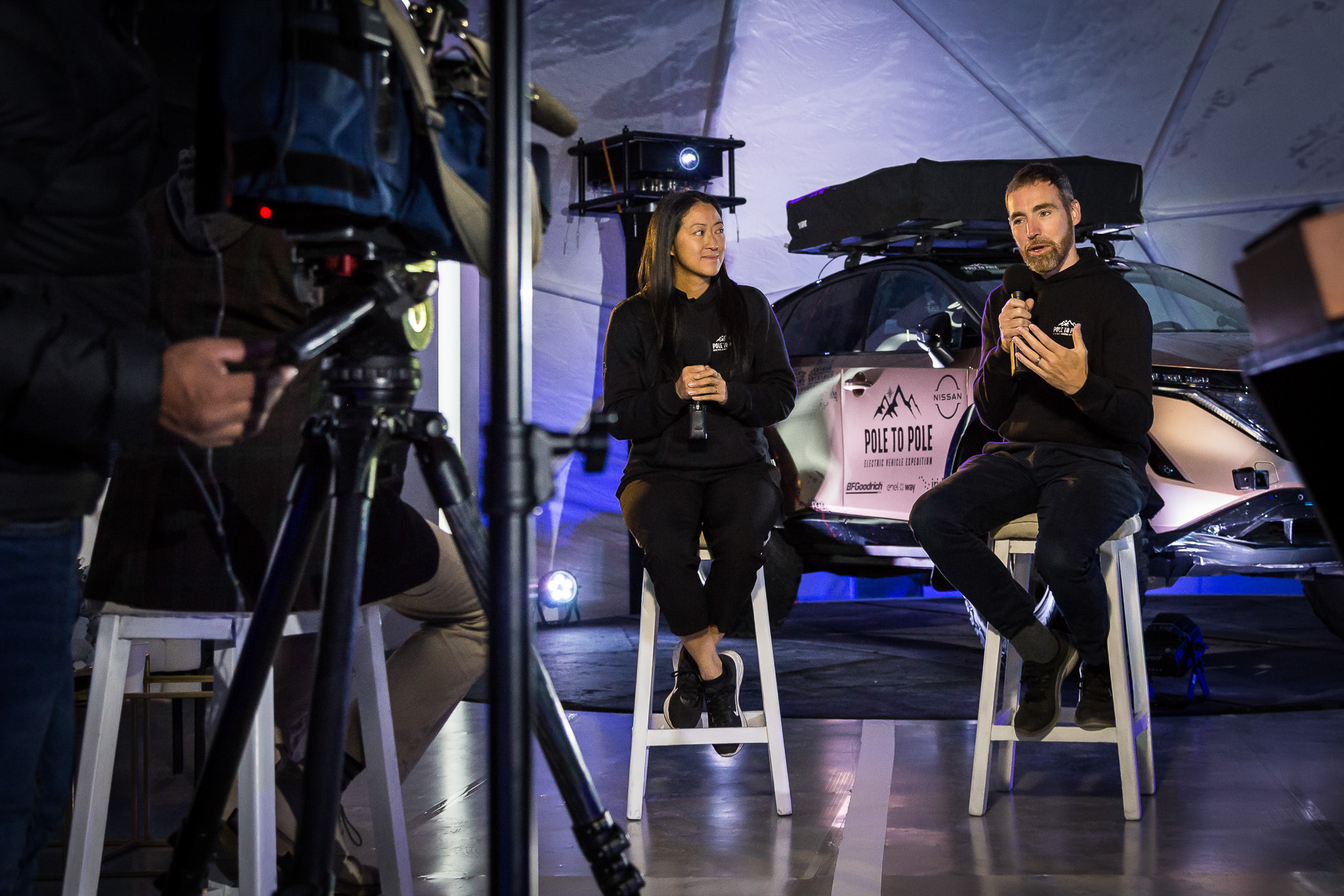
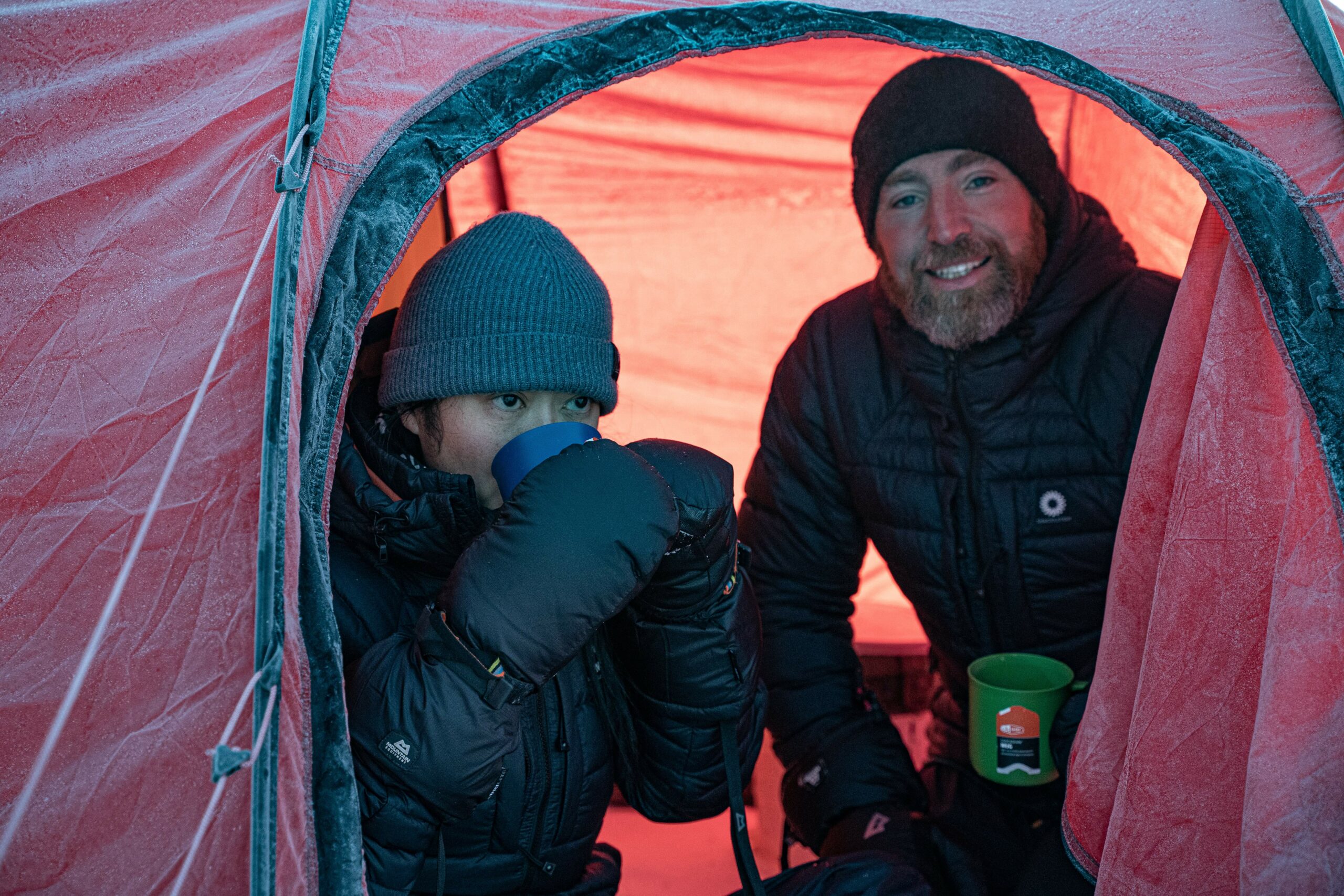
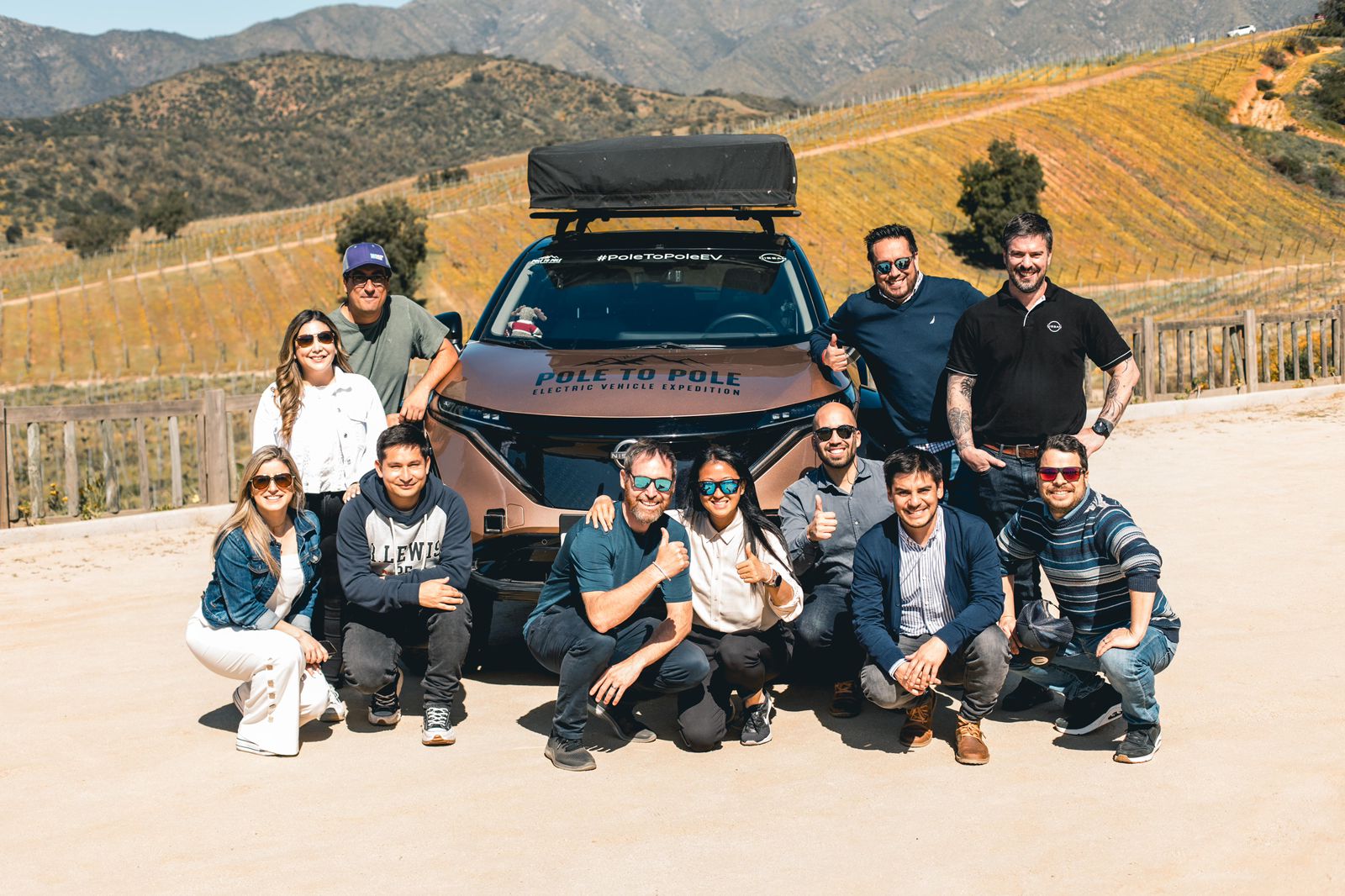
Tell me about your journey into the electric vehicle world.
Chris: I’ve been doing overland EV adventures for about a decade. We got our first electric car back in 2015; however, prior to this, I borrowed a Nissan Leaf from our local dealer and decided to take it on a road trip in the UK with some friends over a long weekend. This was back in 2013. I had a great time and a great laugh, but it was also a bit of a nightmare because there weren’t many chargers in the country. But I loved the challenge and the technology.
Julie: In the 2013 trip, Chris covered Aberdeen to Edinburgh, Edinburgh to London, London to Cardiff, and then Cardiff back to Aberdeen in a long weekend. This was in a 24-kilowatt first-generation Nissan Leaf, and the car had a range of 60 miles at the time. The opinion back then was that people thought they would not make it past the next major town, which is Dundee, 70 miles away.
Chris: There were about 60 chargers in the country; we were dangling cables out of hotel windows and [using] extension leads in all manners of novel ways to charge the car. It’s kind of like what we’re doing now; it was a proper adventure at that point. I shared the trip on social media, and people just loved seeing EVs put through real-world situations. That sparked Plug-In Adventures, which kept going as a hobby and led to more and more long-distance endurance drives.
Julie: You also did trips like [Scotland’s] North Coast 500 in a 30-kilowatt Nissan Leaf. The car had a 110-mile range. Chris could have been the first to do this trip in an EV, but we never verified it.
Chris: We’ve done John O’Groats to Land’s End and back in just over 48 hours in a 60-mile range EV. Then I drove from Edinburgh to Monte Carlo [Monaco], Monte Carlo to London, and London to Edinburgh in 60 hours in a 60-mile BMW I3.
We’re from Aberdeen, Europe’s oil and gas capital, and our backgrounds are in oil and gas. The industry went through a downturn in 2017. I wanted to take a step forward and do this as a career, promoting the benefits and capabilities of EVs full-time. I took redundancy from my day job and decided to enter the Mongol Rally.

What was the significance of driving an EV in the Mongol Rally in 2017?
Julie: This adventure showed everyone, including the car industry, that EVs can drive long distances and travel through countries without EV chargers. We were the first to enter the Mongol Rally with an electric vehicle. [The event] had been going on for 14 years, so every vehicle had been with a combustion engine. The EV we took was a second-generation 30-kilowatt Nissan Leaf, which had a range of about 90 miles because of the roof rack and the minor modifications we made to the car.
At the time, people thought, Impossible. You guys can’t drive from London to Mongolia in an electric car. You’re not going to make it. There was a lot of skepticism and doubt because no one had done it. Quite frankly, I didn’t know at the time if it was doable, but I figured we would give it a go and see how we got on.
The premise is to have an adventure—that’s the whole point—but the organizers have certain rules. You have to take the most unsuitable car you can find—the more unsuitable the better. It must have an engine size of no more than 1 liter, and it has to be cheap. At the time, our EV didn’t quite fit the cheap car criteria, but the organizers thought, Hell yeah, this is completely unsuitable. They took bets and thought we wouldn’t make it, either. But the whole point is it’s an adventure. Not everyone makes it, right? You’re supposed to have problems and difficulties and engage with the locals—that’s where the memories are created.
Chris: They call the Mongol Rally the most grueling public rally in the world. In contrast to Julie, I had absolutely no doubts we would make it.
What was charging infrastructure like on the Mongol Rally route in 2017?
Julie: We charged 111 times getting to Mongolia. There are 111 mini stories we could tell because every time we charged, we needed help from a local. Some unusual and memorable examples included sleeping in a fireman’s bunkhouse in a Russian fire station and charging at a Kazakh police station while cooking instant noodles on the chief of police’s desk while receiving a marriage proposal every time Chris left the room!
From the UK to Turkey, we used the public electric car charging network that was already available. Public charging options didn’t exist from Turkey onwards, so we would plug into any domestic plug socket. We relied on a single two-pin European domestic plug to charge our car, which was brilliant because we could charge from any building with a power and a plug socket. This allowed us to interact with the locals, experience a bit of the culture, educate people on EVs, and offered the opportunity to spend time in that city or town.
Chris: To finish the Mongol Rally, you can take as long as you want as long as you make it to the finishing line, which was at the time Ulan-Ude in Southern Siberia. We wanted to reach the finishing line because there was a rally podium for photos and a huge party with all the entrants. That meant driving 10,000 miles in 56 days in a car with 90 miles of range. We had to map every 80 to 90 miles on Google with a town, village, or building, turn up, and ask for a domestic charge, which meant we had to sleep in the front seats of our car. I joke and classify it as our most amazing nightmare! But we are pleased that a huge charging network has sprung up across the route since we completed the rally in 2017.
How do you know which locations offer vehicle charging?
Chris: There is an app called PlugShare, which I use extensively to plan. It is a global EV charge point location app. It’s not perfect, as the information is only as good as the last update, but it has helped me with the planning a lot.
In Central and South America, we worked with Enel X Way to discuss, plan, and install charging infrastructure along our route to make the southern leg of our Pole-to-Pole expedition possible. The great thing is this network of chargers can be used by other EV drivers going forward. One of our legacies on this project is to help people transition to electric vehicles in different countries by improving the current infrastructure.

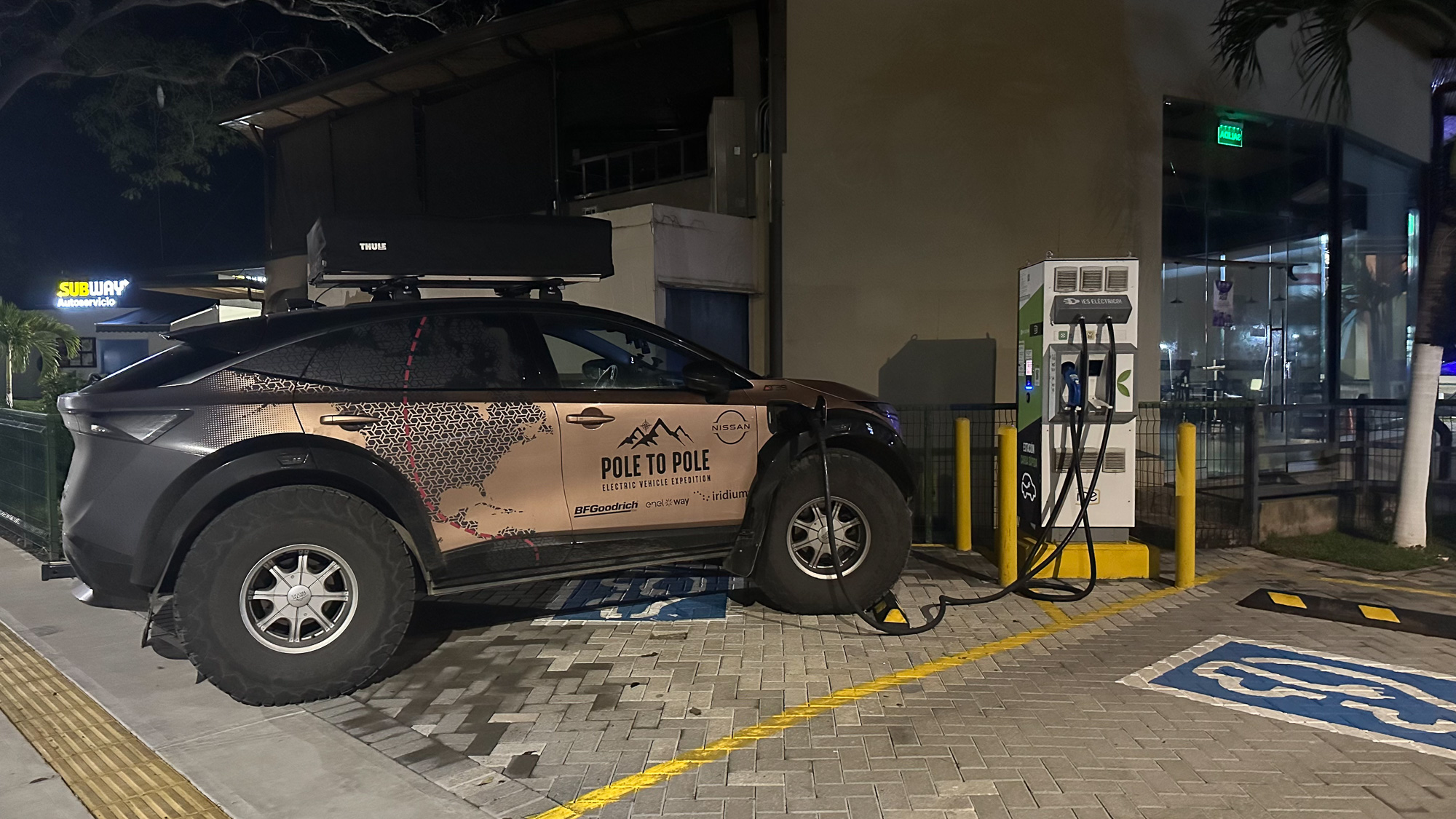
How did your Mongol Rally experience lead to this Pole-to-Pole project?
Chris: When we came home, I was thinking about what we would do next. We absolutely love travel, and I wanted to continue promoting electric vehicles through travel and adventure.
Julie: For us, it was also about showing the wider public there are more sustainable options. Overlanding is a huge industry, and many people do it every year. If we can inspire future overlanders and adventurers to switch or go electric, that would be an amazing benefit to come from our expedition—and with a positive impact on the planet.
It also means people can experience how exciting, smooth, and relaxing EVs are to drive. Having over 300 horsepower, AWD, and instant torque at our disposal comes in really handy when we are navigating multiple terrains, and it shows just how capable EVs really are.
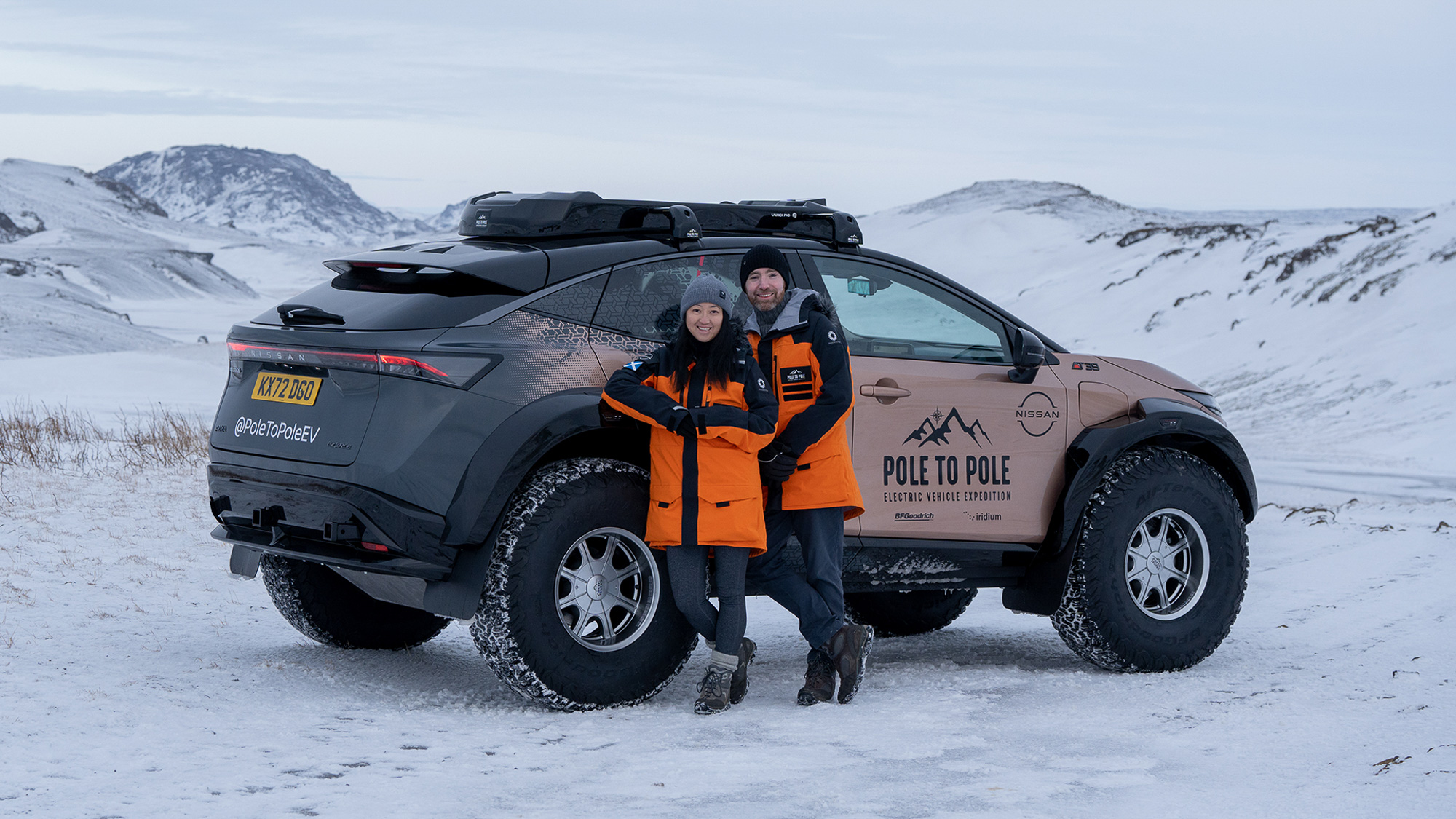
What are the most persistent myths about electric vehicles?
Julie: Range anxiety is definitely one. A lot of people still believe they can’t go long distances. When the vehicles had a range of 60 miles, that was true, but cars now have the ability to reach 300 to 400 miles.
Chris: The biggest thing to overcome is the range. For us, even though we drive long distances, we do small increments in a day while driving long distances over a longer period of time. But in everyday life, people drive short distances every single day, and it’s only a couple of times a year, or maybe for some people, maybe once a month for their jobs, they drive long distances. Nowadays, EV cars have the range capability and can cover the distance most people require in their everyday lives.
Julie: Out of the showroom, the Nissan Ariya has approximately 319 miles of range. After the modifications, namely adding 39-inch BFGoodrich KO2 tires and a Thule Approach rooftop tent, we have approximately halved our range. The fact that we can still complete the expedition with around a 150-mile range demonstrates that it’s possible.
Chris: The other biggest myth that we’re dispelling is the capability of the batteries and how they perform in cold and extreme heat. When we were in Nunavut, north of Cambridge Bay and close to 220 miles northeast into the Arctic Ocean, we were living at -39°C, and the car was performing quite happily.
Julie: There were range limitations to the battery in the extreme cold. Everything was just slower. Charging was slower, but we overcame that. The fact is that it never died on us, which was one of the biggest concerns we all had. It wasn’t perfect, but the car worked well and started every day.
Chris: The cars are tested to these kinds of temperatures. Manufacturers have cold climate chambers in their factories, so I knew it would work, but wondered what would happen for a sustained period. It was a good test, but it was also a way to understand how to introduce extra heat into the battery for more range and better efficiency. It was good learning for Antarctica because it will be even colder [there], around -40°C to -45°C before we look at wind chill. It could go down to around -50°C to -60°C depending on the summer.
Julie: The Arctic was a training ground. It was the first time we’d been somewhere so extreme—and the same can be said for the Nissan Ariya. There were no roads. The best way to describe the experience was extreme polar off-roading. It was just frozen sea ice, frozen lakes, frozen Arctic tundra, hills with sharp rocks, mountains, you name it. It’s harsh out there. It is a majestic place to see and travel across, but take your eye off of the ball for a few minutes, and you can quickly find yourself in serious danger. The year before, another expedition [The Transglobal Car Expedition], lost a vehicle through the ice.

You had the support of Arctic Trucks on that section of the expedition. What role did its team members play?
Chris: I’ve been planning this expedition for about six years and have been talking with Arctic Trucks for that length of time. When I first started talking with the founder of Arctic Trucks, Emil [Grimsson], nobody had driven from the top of the ice road in Yellowknife to Cambridge Bay. Emil had a similar mindset and wanted to help make the project happen. Having this support early on was fundamental to being here today. They were also crucial in helping us plan the route in the Arctic.
Arctic Trucks did all of the modification work on the car. Making those 39-inch BFGoodrich KO2 tires fit on a regular vehicle without increasing the ride height or adding any suspension lift is just fantastic. The car runs on standard suspension, a standard drivetrain, and a standard battery, which some people just can’t quite believe.
From a support level, our Arctic Trucks team was made up of two guys each in a custom-built Ford F-350. Those guys were brilliant. They guided and supported us when needed, occasionally helping us out of really deep snow. The support vehicles also pulled each other out of difficult situations, which demonstrated just how tough it was out there, and just how well the Ariya performed alongside custom-built expedition vehicles.

You received criticism for using combustion support vehicles during that part of the expedition.
Chris: The reason we had diesel support vehicles was because there is no electric polar support expedition vehicle. They don’t exist. Our Nissan Ariya is the first electric polar expedition car. The purpose of this project is to show the potential of electric drive trains for vehicles operating in the polar regions.
This is also a project for Arctic Trucks as much as it is for us, and for them to understand how they could potentially implement electric vehicles or some form of hybridization into their polar expedition fleets. We also required a lot of approvals to enter into the Arctic regions, and those approvals are granted based on having support.
Julie: As you can imagine, it took a lot of convincing to enter into this region, given a previous expedition the year before lost a combustion engine vehicle through the sea ice close to where we were going. Fortunately, the clean-up operation was quick and successful. They retrieved the car, and very little pollution was left.
It’s the first time an electric vehicle has done anything of this magnitude. If we attempted to go into the Arctic with our electric vehicle without support, it would have been reckless and dangerous. Safety is the priority, as we were already asking the expedition team to put their lives at risk to support our vision.

You brought a prototype wind turbine to test its potential as a renewable energy source. How did it perform?
Chris: The expedition is about demonstrating the capabilities of an electric vehicle drivetrain, but I wanted to go one step further and see if we could charge the vehicle from a renewable energy source in the Arctic and Antarctica. Most people would be satisfied with just getting an EV from Pole to Pole, but for us, it is about pushing technology and boundaries. We wanted to see if we could create renewable charging solutions to help expeditions become even more environmentally friendly and leave little trace as they explore the planet.
From that perspective, I came up with the idea of a 5-kilowatt wind turbine on a trailer with a charging device. It’s never been done before. We had to get that created in a very short space of time. It was a huge challenge, but with my knowledge combined with some industry experts, we created the charging trailer and successfully tested it, charging an EV in the UK.
We added the best trailer suspension based on advice, but it turned out to be too stiff. Because the terrain changes so much year to year, it’s too difficult to predict what will work best. Unfortunately, the trailer just kept ripping away from the tow hitch on the vehicle. We had to leave the turbine where it was at that point, as it was slowing us down; we had also been informed that the ice road near Yellowknife was melting.
We had to move faster, which was impossible with the turbine in tow. Staying connected in the Arctic is critical for everyone’s safety, and we were using the Iridium network to receive regular updates and stay connected with Arctic Trucks in Iceland who were acting mission control for this stage of the expedition. We collected the trailer on our way back and took it to Cambridge Bay.
Plus, Mother Nature had other ideas for us. It didn’t blow an ounce of wind in one of the windiest places on the planet. That didn’t go according to plan. We had to use our backup solution, which we had to have as part of the permitting [process], a petrol generator. That was one of the huge challenges and one of the biggest learnings for us.

Julie: Chris put so much heart and soul into creating this wind-charging solution and it just reinforces that this expedition is about pushing boundaries, innovating, learning what works, and where we can improve for Antarctica. Our experience in the Arctic has allowed us to draw upon this and create a new prototype solar hybrid charging solution with a smaller, more lightweight inverter for Antarctica and harness renewable energy.
While the Arctic was a big challenge for us, on the opposite side of the scale, while we were in the middle of nowhere, we spotted a lone, gorgeous polar bear in the wild. That moment was just magical. The team was in awe. That was definitely one of our biggest highlights. We were also very fortunate to witness the amazing northern lights on our last night before reaching the safety of civilization. That was just spectacular.

Follow Chris and Julie’s Pole-to-Pole EV expedition via the couple’s website, Instagram, and Facebook pages.
Our No Compromise Clause: We do not accept advertorial content or allow advertising to influence our coverage, and our contributors are guaranteed editorial independence. Overland International may earn a small commission from affiliate links included in this article. We appreciate your support.
Read more: Have We Found the Best EV for Overlanding?


